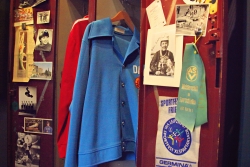Cold War relics put Culver City on the cultural map
By Lori Fusaro
For 10 years, Justinian Jampol, executive director and founder of The Wende Museum has been preparing to move the museum, now located in an office building near Fox Hills Mall, to a more central location.
Culver City’s armory will be the future site for the museum’s collection of more than 75,000 artifacts and relics of the Cold War. For the first time, the museum will make its significant resources accessible to the public.
The National Guard previously occupied the armory and when they decided not to renew their lease Jampol approached the city.
“Wende needed more space and the city was interested in a quality user for the building, one who was willing and able to pay the costs to repair, rehab or re-construct as appropriate for its use,” said Councilman Andrew Weissman.
The armory building requires significant upgrades, as it has been a fairly unused facility. The plans include an eco-friendly restoration and will greatly enhance the community.
“We have been working in close coordination with city manager John Nachbar and Martin Cole. Sol Blumenfeld is overseeing the permitting, rezoning and review processes,” said Jampol.
Jampol, a native of Los Angeles and scholar of modern European history, founded the museum to address the neglect and destruction of Cold War material culture in Eastern Europe and the Soviet Union that followed the fall of the Berlin Wall in 1989.
During the early 1990s, these materials that document an entire cultural history of what life was like in Eastern Europe and the Soviet Union, were rapidly disappearing.
Historical landmarks were being torn down, statues vandalized, consumer products discarded, film and photographs left to deteriorate and archives actively destroyed.
The Wende Museum collection originated with items acquired by Jampol in the mid-1990s and quickly expanded in 2000 with a significant donation by activist Alwin Nachtweh and his partner Ulrike Wolf.
Because of this large acquisition, a bigger space was imperative.
The residents of the Veterans Park area where the armory is located have been kept apprised of the changes coming to their neighborhood. There have been several meetings to help alleviate the concerns expressed during the initial stages of development.
Dan O’Brien, a Veterans Park resident has been a key sounding board for concerned neighbors. The biggest reservations were the potential increase in traffic and noise.
“I was up front with Justinian that the neighborhood would rightly be concerned about any potential noise or traffic impacts that the museum might create and that they should ask for the community’s input from the get go. Justinian and his team did just that by holding an open house for Vet’s Park neighbors to attend and ask questions,” said O’Brien.
“We commissioned a traffic assessment letter, a parking plan, a full survey, analysis of the paint and other environmental issues, and are continuing to work closely with the city to push ahead as quickly as possible,” said Jampol.
In conjunction with the Jazz Bakery, the museum has partnered the city of Culver City to request a grant from the National Endowment of the Arts. It will connect the downtown arts district with the 405 freeway, the city’s Westside artery, forming a cultural corridor. Grant recipients will be announced in the fall.
The cultural corridor idea builds on Culver City’s commitment to arts and culture and has been shaped and cultivated by councilmember Jim Clarke.
The Culver City armory property, just short of an acre, includes open land that the museum will convert into a sculpture garden and community gathering space, where its 11 Berlin Wall segments will be installed.
“Moving the Wende into the armory building will transform a run down Cold War relic into a new showcase for a treasure trove of history from the Cold War Era. The Cold War was an era that is literally etched into the way I view the world today,” said O’Brien.
This plan is a big step for the museum and the community and will continue to expand on the Wende’s vision of open access and innovative exhibitions that fuse art and history.
“There are a lot of processes and hoops to jump through – this is all new to us and we want to make sure that we do everything right. The city has been very helpful and instructive all along the way,” said Jampol.
“The benefits to Culver City are many, but 2 important benefits are a world class museum focusing on an era of history that is not covered by any other museum in the Western Hemisphere. The other is that the Wende will work with our school district to bring in children for tours and education purposes,” said Culver City Mayor Jeff Cooper.
The armory will increase the Wende’s exhibition space threefold and enable the museum to separate offices and research workspaces, collections receiving and processing areas, and artifact storage.
“We have a comprehensive education plan that will engage Culver City schools and provide opportunities for hands-on learning multiple times a year,” said Jampol.
Besides segregating and establishing microclimates for different collection formats, controlled lighting and increased security, the museum will also take this opportunity to transition the collection into a combination of visitor-accessible open storage and efficient compact storage.
“When this museum is completed, my hope is that Culver City schools will utilize everything the museum has to offer to broaden their students’ understanding of the world we live in today,” said O’Brien.
“No plan is perfect, but with the continuing input and support of the Vet’s Park community, the future of the Wende at the Armory will be incredibly bright,” said Jampol.
“We appreciate the opportunity to continue to reach out to the community, which has been really wonderful and supportive. We are here because of them.”

